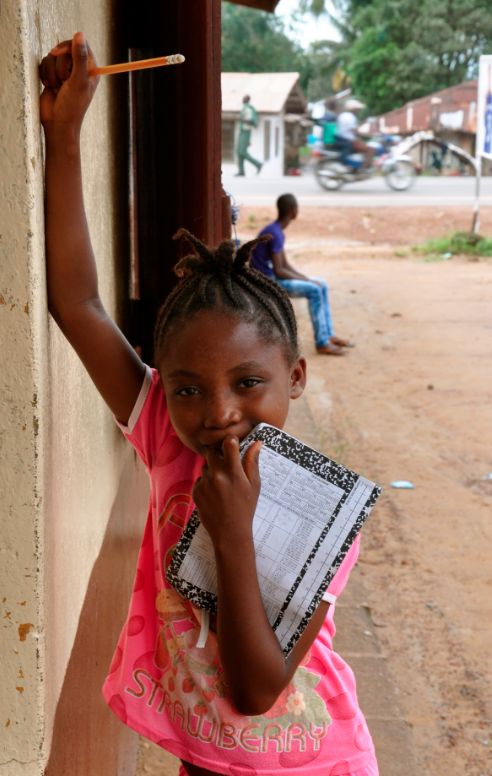Water and sanitation professionals work tirelessly to improve health, promote food security, and boost livelihoods. To further USAID’s knowledge sharing goals, the Water Office holds learning events that present solutions and challenges common to water programs. In Currents, we share the solutions discussed at the events and other venues. Email us at waterteam@usaid.gov if you would like your project to be considered for Global Waters.
Let Girls Learn Initiative Aims to Improve WASH and Education

Around the world, 62 million girls are not in school and millions more are fighting to stay in school. This negatively impacts global health and livelihoods. When girls are educated, their families are healthier, they have fewer children, they wed later, and they have more opportunities to generate income. Let Girls Learn is a USAID-led initiative that strives to help all girls to get a quality education.
More than two-dozen celebrities, including Susan Sarandon, Anne Hathaway, and Alicia Keys, joined forces with USAID for the launch of Let Girls Learn. Through its website, the public can make donations and choose whether they go toward school uniforms, a Dream Bike to help girls get to school, school meals, access to clean water at schools, books and other learning materials, or fees that come with running and maintaining a school.
In support of this effort, USAID announced more than $230 million for new education programs in Nigeria, Afghanistan, South Sudan, Jordan, and Guatemala. These programs will provide girls with better-trained teachers, scholarships, and transportation to and from school. They will improve WASH in schools and increase access to and quality of education for thousands of girls, including indigenous children and refugees.
To learn more, visit www.usaid.gov/letgirlslearn, and share ways to help educate girls on Facebook, Instagram, and Twitter using the hashtag #LetGirlsLearn.
Safeguarding The World’s Water Report Released
USAID recently released its annual “Safeguarding the World’s Water” report, which highlights water programming for Fiscal Year (FY) 2013. USAID’s water programs protect and strengthen water resources for the well being of both people and the environment throughout the developing world, and support the goals of the Paul Simon Water for the Poor Act. Last year, more than 3.5 million people gained improved access to drinking water supply, and nearly 1.3 million people gained improved access to sanitation facilities, as a result of these programs.
With one in nine people worldwide without access to improved water sources, the impact that safe water and improved sanitation can deliver is transformational. Safeguarding the World’s Water examines how this programming, which totaled $523,783,000 in FY 2013, is reaching vulnerable populations, using innovation, partnering with public and private stakeholders, and helping build resilience in the developing world.
Because the Agency’s new Water and Development Strategy was released in FY 2013, programming around its Strategic Objectives of water for health and water for food did not begin until FY 2014. However, to show progression towards those objectives, the report is organized with them in mind and explores the integration of health and food security.
You can learn more or read the report on USAID’s website.
H2infO Portal Launched
On October 6, 2014, the U.S. Department of State launched H2infO, an online portal that gives the global public access to a growing library of U.S. water data and knowledge. The portal was created by the U.S. Water Partnership, a membership organization that brings together government agencies, the private sector, NGOs, and academic research institutions from the United States to promote water cooperation and share their expertise with the global community.
The portal includes reports, raw data, technical guidance, blog posts, innovative learning materials, and other documents of use to the global water community. The learning materials are organized into four subject areas: water, sanitation, and hygiene (WASH); water productivity and efficiency; governance; and integrated water resource management (IWRM).
At the launch, Catherine A. Novelli, Under Secretary of State for Economic Growth, Energy, and the Environment, said that sharing lessons learned, as H2infO does, will lead to meaningful progress on water issues around the world, and urged the water community to contribute to the portal. “Everyone on the planet is a clean water stakeholder,” she said. “We’re in this together – and it’s only by working together and sharing knowledge and resources that we will continue to survive and thrive.”
To access the portal, visit h2infO.us.
World Water Week 2014 Focuses on Water and Energy
World Water Week 2014 took place from August 31 to September 5 in Stockholm, Sweden. The annual event brought together the world’s leading water, environment, and resilience scientists and experts to discuss issues related to its theme of water and energy.
This year’s event broke previous attendance records with more than 3,000 participants from more than 140 countries. USAID representatives presented on many topics at more than 100 sessions, including the Agency’s Sustainability Index Tool, links between WASH and nutrition, and water and energy governance in Nigeria. USAID Global Water Coordinator Chris Holmes announced 17 nominees in its Securing Water For Food Grand Challenge For Development. These nominees will receive funding to pilot innovations that improve agricultural water use.
Throughout the week, experts called for increased coordination between the water and energy sectors. At the Week’s opening session, Torgny Holmgren, Executive Director of World Water Week organizer Stockholm International Water Institute, said, “With the global demand for water projected to grow by 55 percent between 2000 and 2050 and electricity demand expected to increase by 50 percent in the next two decades, there is an urgent need for a closer relationship between the energy and water communities if we are to provide solutions for all peoples to prosper.”
To learn more, download the Overarching Conclusions for 2014 World Water Week pamphlet.







Comment
Make a general inquiry or suggest an improvement.